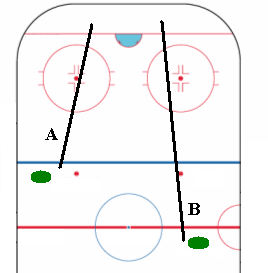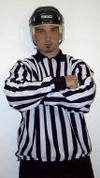
For a puck shot towards the top of the diagram, example "A" is not icing. Example "B" is icing.
Icing in ice hockey occurs when a player shoots the puck across at least two red lines, the opposing team's goal line being the last, and the puck remains untouched. When icing occurs, a linesman stops play. Play is resumed with a faceoff in the defending zone of the team that committed the infraction.
In European professional leagues, some lower-level North American professional leagues (ECHL and Central Hockey League), and most amateur leagues worldwide, play is stopped for icing once the puck crosses the goal line. This is called automatic or no-touch icing.
In the NHL and AHL, along with many North American professional leagues, a player on the opposing team other than the goaltender must touch the puck to cause the stoppage of play. If the puck is first touched by the goaltender or a player on the team that iced the puck, icing is waved off (cancelled) and play continues. The icing rule can lead to high-speed races for the puck. While an icing call is pending, the linesman raises an arm to indicate that a potential icing call may be made. If the icing is waved off, the official lowers his arm and gives the washout signal (extending both arms sideways from the body at shoulder height).
Icing is always waved off in the following situations:
- The team committing the icing is shorthanded.
- The linesman believes a player on the opposing team (other than the goalkeeper) could have played the puck before it crossed the goal line.
- In the NHL, the linesman deems the icing is the result of an attempted receivable pass.
The 1970s era World Hockey Association professional league never adopted the NHL rule of allowing shorthanded teams to ice the puck while engaged in the penalty kill. In 2009, USA Hockey is considering eliminating the shorthanded icing rule, having tested its elimination in Massachusetts and Alaska in the 2007 to 2009 seasons.
Rationale[]
The icing rule was introduced to prevent instances where teams facing a much stronger opponent often resorted to pure defense, simply shooting the puck up the ice every time they gained possession, resulting in an unexciting spectacle. Some teams also adopted this tactic to waste time when they were ahead late in the game, especially if the score was still close. The NHL instituted the icing rule on March 13, 1939.
After some teams in need of a line change (player substitution) began deliberately icing the puck to stop play, the NHL supplemented the icing rule prior to the 2005-06 season by not allowing the offending team to substitute players before the next faceoff. This change was made in an effort to speed up game play by reducing icing infractions. In some Junior leagues (such as the WHL), the offending team is permitted to substitute players after an icing only if the puck was shot from the neutral zone (between the defensive blue line and the red line). If the violation occurs in the defensive zone, substitution is prohibited.
Referee signals[]

The rear linesman signals icing by raising his non-whistle hand. In the WHL, a potential defensive-zone icing is indicated by also extending the whistle arm in the direction of the icing call.

When the puck has crossed the goal line (and in North American professional hockey, a non-offending player has touched the puck) the rear official signals icing by folding his arms in front of his chest.
